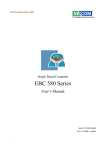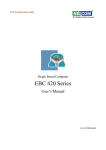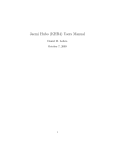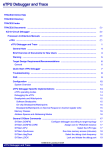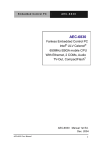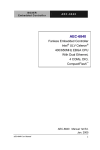Download 96M5791 User's Manual
Transcript
96M5791 Single Board Computer User’s Manual Edition 1.0 2007 k Preface Copyright This publication, including all photographs, illustrations and software, is protected under international copyright laws, with all rights reserved. No part of this manual maybe reproduced, copied, translated or transmitted in any form or by any means without the prior written consent from DSM Computer AG. Version 1.0 Copyright 2007 Disclaimer The information in this document is subject to change without prior notice and does not represent commitment from DSM Computer AG. However, users may update their knowledge of any product in use by constantly checking its manual posted on our website: http://www.DSM.AG The DSM shall not be liable for direct, indirect, special, incidental, or consequential damages arising out of the use of any product, nor for any infringements upon the rights of third parties, which may result from such use. Any implied warranties of merchantability of fitness for any particular purpose is also disclaimed. Acknowledgements The 96M5791 is a trademark of the DSM Computer AG. All other product names mentioned herein are registered trademarks of their respective owners. Regulatory Compliance Statements This section provides the FCC compliance statement for Class A devices and describes how to keep the system CE compliant. Federal Communications Commission (FCC) For Class A Device This equipment has been tested and verified to comply with the limits for a Class A digital device, pursuant to Part 15 of FCC Rules. These limits are designed to provide reasonable protection against harmful interference when the equipment is operated in a commercial environment. This equipment generates, uses, and can radiate radio frequency energy and, if not installed and used in accordance with the instructions, may cause harmful interference to radio communications. Operation of this equipment in a residential area (domestic environment) is likely to cause harmful interference, in which case the user will be required to correct the interference (take adequate measures) at their own expense. 96M5791 User's Manual / Page 2 CE Certification The product described in this manual complies with all applicable European Union (CE) directives if it has a CE marking. For computer systems to remain CE compliant, only CE-compliant parts may be used. Maintaining CE compliance also requires proper cable and cabling techniques. WARNINGS Read and adhere to all warnings, cautions, and notices in this guide and the documentation supplied with the chassis, power supply, and accessory modules. If the instructions for the chassis and power supply are inconsistent with these instructions or the instructions for accessory modules, contact the supplier to find out how you can ensure that your computer meets safety and regulatory requirements. CAUTION Electrostatic discharge (ESD) can damage NSA components. Do the described procedures only at an ESD workstation. If no such station is available, you can provide some ESD protection by wearing an antistatic wrist strap and attaching it to a metal part of the computer chassis. Safety Information Before installing and using the 96M5791, note the following precautions: Read all instructions carefully. Do not place the unit on an unstable surface, cart, or stand. Follow all warnings and cautions in this manual. When replacing parts, ensure that your service technician uses parts specified by the manufacturer. Avoid using the system near water, in direct sunlight, or near a hearing device. 96M5791 User's Manual / Page 3 Table of Content Preface……………...……………..……………………………………….………….……..……………..2 Copyright………………..……………………………………….…………………………………….... 2 Disclaimer………………………..………………………………..…………………………………….. 2 Acknowledgements……………………………………………..……………………………..…..…… 2 Regulatory Compliance Statements……………………..…………………………………….……………2 Federal Communications Commission (FCC) For Class A Device……………..……….…………..…..…2 CE Certification………………………………………………………………………….……….………...3 Safety Information……………………………………………………………………….………..………..3 Table of Content………………………………………………………………………………….…….......4 Chapter 1 General Information 1.1 Main Features…………………………………………………….……………………………………..6 1.2 Specification…………………………………………………….…………………………………….. 6 1.3 Power Consumption Measurement……………………………………………………………………..8 1.4 Board Layout…………………………………………………………………….… …………………. 9 1.5 Board Dimensions……………………………………………………….………… …….…………… 9 Chapter 2Jumper Setting 2.1 Before You Begin……………………………………………..….……………………………………11 2.2 Precautions………………………………………………………………………………………... …..11 2.3 Setting Jumpers…………………………………………………………………………………… …..12 2.4 Location of Jumpers………………………………………………………………………………. …..13 2.5 Function of Jumper………………………….……………………………………………………........13 Chapter 3 Expansion 3.1 System Memory………………………………………………………………………………….…….24 3.2 Installing DIMM………………………………………………………………………………….. ….. 24 3.3 Installing Compact Flash………………………..…………………………………………………….. 26 96M5791 User's Manual / Page 4 Chapter 1 General Information 96M5791 User's Manual / Page 5 Main Features Specification CPU Support VIA Eden V4 1 GHz VIA C7-D 1.5 GHz Main Memory 1 x 184-pin DIMM Socket for up to 1 GB un-buffered non-ECC DDR 333/400 memory Chipset VIA® CN700 VIA® 8237R+ BIOS Award System BIOS Supports Power On after power fail as a BIOS option Supports Wake on LAN 4 Mbit flash ROM On-board LAN 2 x 10/100/1000 network connection RTL8110SC Each LAN port reserved with 2-pin header for extended LAN LED (Active, Link 100, and 1000 LAN LED) 96M5791 User's Manual / Page 6 Supports Wake on LAN (When 5 Vsb power available). (LAN1 is available for Wake up, LAN2 is not available for Wake up) Audio VIA, VT1616 CODEC for AC97 V 2.0 MIC-in, Speaker-out Display LVDS1: VIA VT1636 transmitter, 2 x DF13-20 DP, 20-pin connector for LVDS1 panel output LVDS2: VIA VT1636 transmitter, 2 x DF13-20 DP, 20-pin connector for LVDS2 panel output CCFL: 2 x CCFL for LCD panel backlight inverter power VGA: 1 x DB15 VGA connector I/O Interface Serial port: 4 ports, with 1x 40 pin header, COM 2 for RS 232/422/485 USB 2.0 x 4 Parallel port: 1 port, with 2x13 box header (2.0 mm) PS/2: 1 x Mini-Din for Keyboard/Mouse Digital I/O: 2x4 pin header (2.54 mm) IrDA: on-board pin header for IrDA Tx/Rx SMBus 2.0 controller On-board header for reset SW and HD active LED I2C: On-board 3-pin header for I2C, one pin for GND Watchdog Timer Watchdog timeout is programmable by software from 1 second to 64 seconds On-board RTC On-chip RTC with battery back up 1 x External Lithium battery Storage HDD: 1 x 44-pin connector (secdonary) System Monitor Derived from Super I/O to support system monitor Monitoring of 5 voltages, 3 temperatures and 2 fan speeds. 5 voltage (For +3.3 V, +5 V, +12 V, Vcore and +2.5 V) 3 temperature (For CPU and two external for system) 3 fan speed ( one for CPU and 2 for systems) Power Input 3-pin header for AT/ATX mode switch +3.3 V is converted from +5 V 6-pin power input connector 3-pin Jst connector to receive the 5 Vsb input from power source Factory default setting is AT Mode ATX Mode 96M5791 User's Manual / Page 7 Power required: +12 V/+5 V/+5 Vsb Supports Power On push Button, Software Shutdown function and LAN1 remote wake up only. 2-pin Header for Power On Push Button AT mode Power Required: +5 V/+12 V No Power On push Button, No Software Shutdown function and No LAN1 remote wake up Dimensions 5.25" form factor 203 mm(L) x 146 mm (W) (7.9” x 5.7”) Environment Board level operating temperature: 0°C to 60°C Storage temperature: -20°C to 80°C Relative humidity: 10% to 90% (Non-condensing) Certifications CE approval FCC Class A 1.3 Power Consumption Measurement 96M5791 Power Consumption Power Type +12V +5V +5VSB Mode Power-On 0.81A 2.70A x AT Mode HCT 1.30A 2.80A 0.28A ATX Mode 96M5791 User's Manual / Page 8 1.4 Board Layout Figure 1.2: Overview of 96M5791 1.4 Board Dimensions Figure 1.3: Mechanical Drawing of 96M5791 96M5791 User's Manual / Page 9 Chapter 2 Jumper Setting 96M5791 User's Manual / Page 10 This chapter of the User’s Manual describes how to set jumpers. 2.1 Before you begin Ensure you have a stable, clean working environment. Dust and dirt can get into components and cause a malfunction. Use containers to keep small components separated. Adequate lighting and proper tools can prevent you from accidentally damaging the internal components. Most of the procedures that follow require only a few simple tools, including the following: ♦ A Philips screwdriver ♦ A flat-tipped screwdriver ♦ A set of jewelers Screwdrivers ♦ A grounding strap ♦ An anti-static pad Using your fingers can disconnect most of the connections. It is recommended that you do not use needle-nosed pliers to disconnect connections as these can damage the soft metal or plastic parts of the connectors. Before working on internal components, make sure that the power is off. Ground yourself before touching any internal components, by touching a metal object. Static electricity can damage many of the electronic components. Humid environment tend to have less static electricity than dry environments. A grounding strap is warranted whenever danger of static electricity exists. 2.2 Precautions Computer components and electronic circuit boards can be damaged by discharges of static electricity. Working on the computers that are still connected to a power supply can be extremely dangerous. Follow the guidelines below to avoid damage to your computer or yourself: ♦ Always disconnect the unit from the power outlet whenever you are working inside the case. ♦ If possible, wear a grounded wrist strap when you are working inside the computer case. Alternatively, discharge any static electricity by touching the bare metal chassis of the unit case, or the bare metal body of any other grounded appliance. ♦ Hold electronic circuit boards by the edges only. Do not touch the components on the board unless it is necessary to do so. Don’t flex or stress the circuit board. ♦ Leave all components inside the static-proof packaging that they shipped with until they are ready for installation. ♦ Use correct screws and do not over tighten screws. 96M5791 User's Manual / Page 11 2.3 Setting Jumpers A jumper is the simplest kind of electric switch. It consists of two metal pins and a cap. When setting the jumpers, ensure that the jumper caps are placed on the correct pins. When the jumper cap is placed on both pins, the jumper is SHORT. If you remove the jumper cap, or place the jumper cap on just one pin, the jumper is OPEN. Please see the following illustrations The illustrations on the right show a 2-pin jumper. When the jumper cap is placed on both pins, the jumper is SHORT. If you remove the jumper cap, or place the jumper cap on just one pin, the jumper is OPEN. Open (Off) These illustrations show a 3-pin jumper. Pins 1 and 2 are SHORT. Table 2-1: Setting Jumpers 96M5791 User's Manual / Page 12 Short (On) 2.4 Location of Jumpers 1 2 1 JP1 1 JP2 1 JP19 1 2 J2 CN2 CN3 1 1 1 2 CN9 1 1 JP5 J7 J8 PCI Slot 1 2 1 1 2 FAN1 J3 1 JP3 1 Line out JP4 1 CN4 Mic Input Compact Flash Socket CN5 0987654321 SW1 NB ON JP10 JP11 VGA 1 1 JP17 1 2 1 2 1 JP14 1 JP15 1 JP16 1 LAN1 1 SB LAN2 CPU 7 CN1 D I M M * 1 JP12 =PIN 1 J1 JP9 1 1 1 JP13 USB*2 JP6 JP8 JP18 1 CON1 FAN2 1 J4 1 2 IDE 1 1 1 1 JP7 SATA2 SATA1 1 1 K/M JP20 Figure 2-1: Jumper Location 2.5 Functions of Jumpers and Connectors ◎ J7(CD Input):JST 1x4 2.0mm Male 180-degree connector Pin NO. Description Pin NO. Description 1 Left sound channel 3 GND 2 GND 4 Right sound channel ◎J8 (Line Input):JST 1x4 2.0mm Male 180-degree connector Pin NO. Description Pin NO. Description 1 Left sound channel 3 GND 2 GND 4 Right sound channel ◎J1 (USB)::JST 1x6 2.0mm Male 180-degree connector Pin NO. Description 1 VCC5 4 USBP3N 2 USBP2N 5 USBP3P 3 USBP2P 6 GND ◎J3 (CCFL)::JST 1x7 2.0mm Male 180-degree connector Pin NO. Description Pin NO. Description 1 VDD5SAFE 5 GND 2 +12V 6 GND 3 +12V 7 Back light Enable 4 Back light control 96M5791 User's Manual / Page 13 ◎J4(5VSB connector):JST 1x3 2.5mm Male 180-degree connector Pin NO. Description 1 5VSB 2 GND Pin NO. 3 Description PSON# ◎JP9(LAN2 Active LED):Pin header 1x2 2.54mm Male 180-degree connector Pin NO. 1 Pin NO. Description Pull up to 3.3V 2 Description Active signal ◎JP12(LAN2 100 Speed LED):Pin header 1x2 2.54mm Male 180-degree connector Pin NO. 1 Pin NO. Description Pull up to 3.3V 2 Description 100 Speed signal ◎JP13(LAN2 1000 Speed LED):Pin header 1x2 2.54mm Male 180-degree connector Pin NO. 1 Pin NO. Description Pull up to 3.3V 2 Description 1000 Speed signal ◎JP14(LAN1 Active LED):Pin header 1x2 2.54mm Male 180-degree connector Pin NO. 1 Pin NO. Description Pull up to 3Vdual 2 Description Active signal ◎JP15(LAN2 100 Speed LED):Pin header 1x2 2.54mm Male 180-degree connector Pin NO. 1 Pin NO. Description Pull up to 3Vdual 2 Description 100 Speed signal ◎JP16(LAN1 1000 Speed LED):Pin header 1x2 2.54mm Male 180-degree connector Pin NO. 1 Pin NO. Description Pull up to 3Vdual 2 Description 1000 Speed signal ◎JP11(IrDA) :Pin header 1x5 2.54mm Male 180-degree connector Pin NO. Pin NO. Description Description 1 +5V 4 GND 2 NC 5 IRTX 3 IRRX ◎JP17(Digital I/O):Pin header 2x4 2.54mm Male 180-degree connector Pin NO. Description Pin NO. Description 1 Digital Input 1 2 Digital Output 1 3 Digital Input 2 4 Digital Output 2 96M5791 User's Manual / Page 14 5 Digital Input 3 6 Digital Output 3 7 Digital Input 4 8 Digital Output 4 ◎JP4(CF mode select):Pin header 1x3 2.54mm Male 180-degree connector Pin NO. 1-2 Description Master Pin NO. 2-3 Description Slave ◎JP8(CMOS Clear) Pin NO. 1-2 Description Normal Pin NO. 2-3 Description Clear ◎JP7(Power Button) Pin NO. 1 Description Power ON Pin NO. 2 Description GND ◎JP5(HD active LED):Pin header 1x2 2.54mm Male 180-degree connector Pin NO. 1 Description Pull up to +5V Pin NO. 2 Description HD avtive signal ◎JP3(Panel power select):Pin header 1x3 2.54mm Male 180-degree connector Pin NO. 1-2 Description +5V Input Pin NO. 2-3 Description +3V Input ◎JP1(RESET Button) :Pin header 1x2 2.54mm Male 180-degree connector Pin NO. 1 Description RESET Pin NO. 2 Description GND ◎JP2(SMBus) :Pin header 1x3 2.0mm Male 180-degree connector Pin NO. Description 1 SMBus Data 2 SMBus Clock Pin NO. 3 Description GND ◎JP18(I2C Bus) :Pin header 1x3 2.0mm Male 180-degree connector Pin NO. Description 1 I2C Data 2 I2C Clock Pin NO. 3 Description GND ◎JP20 (Power Select) Pin NO. 1-2 Description AT power supply Pin NO. 2-3 Description ATX power supply 96M5791 User's Manual / Page 15 ◎JP6(Thermister):Pin header 1x2 2.54mm Male 180-degree connector ◎JP10(Second COM port RI# function select):Pin header 1x3 2.54mm Male 180-degree connector Pin NO. Description 1-2 +12V 2-3 +5V Pin NO. 4-5 Description RI# ◎CON1(Power connector):1x6 3.96mm Male 180-degree connector Pin NO. Pin NO. Description Description 1 +12V 4 GND 2 GND 5 +5V 3 GND 6 +5V ◎FAN1(FAN):Pin header 1x3 2.54mm Male 180-degree connector Pin NO. Description Pin NO. Description 1 GND 3 FAN speed sense 2 +12V ◎FAN2(FAN):Pin header 1x3 2.54mm Male 180-degree connector Pin NO. Description Pin NO. Description 1 GND 3 FAN speed sense 2 +12V ◎CN1 (Parallel port):Box header 2x13 2.0mm 180-degree connector Pin NO. Description Pin NO. Description 1 Strobe# 14 Auto form feed# 2 DATA0 15 Error# 3 DATA1 16 Initialize 4 DATA2 17 Printer select IN# 5 DATA3 18 Chassis GND 6 DATA4 19 Chassis GND 7 DATA5 20 Chassis GND 8 DATA6 21 Chassis GND 9 DATA7 22 Chassis GND 10 Acknowledge# 23 Chassis GND 11 Busy 24 Chassis GND 12 Paper empty 25 Chassis GND 13 Printer select 26 NA 96M5791 User's Manual / Page 16 ◎CN5 (LVDS1) (Slave) Pin NO. Description Pin NO. Description 1 NA 2 NA 3 Panel Power 4 A0P 5 A3P 6 A0M 7 A3M 8 Panel Power 9 GND 10 A1P 11 CLK2P 12 A1M 13 CLK2M 14 GND 15 GND 16 +12V 17 A2P 18 +12V 19 A2M 20 GND ◎CN4 (LVDS1) (Master) Pin NO. Description Pin NO. Description 1 NA 2 NA 3 Panel Power 4 B0P 5 B3P 6 B0M 7 B3M 8 Panel Power 9 GND 10 B1P 11 CLK1P 12 B1M 13 CLK1M 14 GND 15 GND 16 +12V 17 B2P 18 +12V 19 B2M 20 GND ◎CN2 (LVDS2) (Slave) Pin NO. Description Pin NO. Description 1 NA 2 NA 3 Panel Power 4 DOB0P 5 DOB3P 6 DOBOM 7 DOB3M 8 Panel Power 9 GND 10 DOB1P 11 DOCLK2P 12 DOB1M 13 DOCLK2M 14 GND 15 GND 16 +12V 17 DOB2P 18 +12V 19 DOB2M 20 GND 96M5791 User's Manual / Page 17 ◎CN3 (LVDS2) (Master) Pin NO. Description Pin NO. Description 1 NA 2 NA 3 Panel Power 4 DOA0P 5 DOA3P 6 DOAOM 7 DOA3M 8 Panel Power 9 GND 10 DOA1P 11 DOCLK1P 12 DOA1M 13 DOCLK1M 14 GND 15 GND 16 +12V 17 DOA2P 18 +12V 19 DOA2M 20 GND ◎CN12 (Line out) Pin NO. Pin NO. Description Description 1 GND 4 NC 2 Right sound channel 5 Left sound channel 3 NC ◎CN11 (Microphone Input) Pin NO. Description Pin NO. Description 1 GND 4 NC 2 Microphone Input 5 Microphone BIAS 3 NC ◎CN9 (4 x COM):Box header 2x20 2.0mm connector Pin NO. Description Pin NO. Description 1 Data carrier detect A 2 Data set ready A 3 Receive data A 4 Request to send A 5 Transmit data A 6 Clear to send A 7 Data terminal ready A 8 Ring indicator A 9 GND 10 NC 11 Data carrier detect B (RS422/485 TX+) 12 Data set ready B (RS422 RTS-) 13 Receive data B (RS422/485 TX-) 14 Request to send B (RS422 RTS+) 15 Transmit data B (RS422 RX+) 16 Clear to send B (RS422 CTX+) 17 Data terminal ready B (RS422 RX-) 18 Ring indicator B (RS422 CTX-) 19 GND 20 NC 21 Data carrier detect C 22 Data set ready C 23 Receive data C 24 Request to send C 25 Transmit data C 26 Clear to send C 27 Data terminal ready C 28 Ring indicator C 96M5791 User's Manual / Page 18 29 GND 30 NC 31 Data carrier detect D 32 Data set ready D 33 Receive data D 34 Request to send D 35 Transmit data D 36 Clear to send D 37 Data terminal ready D 38 Ring indicator D 39 GND 40 NC ◎CN7 (IDE):Box header 2x22 2.0mm connector Pin NO. Description Pin NO. Description 1 RESET# 2 GND 3 DATA7 4 DATA8 5 DATA6 6 DATA9 7 DATA5 8 DATA10 9 DATA4 10 DATA11 11 DATA3 12 DATA12 13 DATA2 14 DATA13 15 DATA1 16 DATA14 17 DATA0 18 DATA15 19 GND 20 NC 21 DMA request 22 GND 23 IOW# 24 GND 25 IOR# 26 GND 27 IOCHRDY 28 Pull down 29 DMA Acknowledge# 30 GND 31 IRQ14 32 NC 33 Disk address1 34 DMA66 Detect 35 Disk address0 36 Disk address2 37 HDC CS1 38 HDC CS3 39 HD active LED 40 GND ◎CN6 (PCI) ◎CN8 (SATA1) Pin NO. Description Pin NO. Description 1 GND 5 RX- 2 TX+ 6 RX+ 3 TX- 7 GND 4 GND ◎CN10 (SATA2) Pin NO. Description Pin NO. Description 1 GND 5 RX- 2 TX+ 6 RX+ 3 TX- 7 GND 4 GND 96M5791 User's Manual / Page 19 ◎DIMM1 (DDR Socket) ◎GPIO ( Super I/O:W83697UF ). Input W83697UF pin name Pin number TIN0 GP17 121 TIN1 GP16 122 TIN2 GP15 123 TIN3 GP14 124 Output W83697UF pin name Pin number TOUT0 GP13 125 TOUT1 GP12 126 TOUT2 GP11 127 TOUT3 GP10 128 ◎ JP19 (Power LED) Pin NO. Description 1 Pin NO. +5V Description 2 GND ◎ SW1 (COM2 Mode Select) NO. 1 2 3 4 5 6 7 8 9 10 RS 232 OFF OFF OFF ON OFF ON OFF OFF OFF OFF RS 422 OFF OFF ON OFF ON OFF ON ON ON ON RS 232 OFF OFF OFF ON OFF ON OFF OFF OFF OFF ◎GPIO Programming guide: Logical Device 7 CRF0 (GP10-GP17 I/O selection register. Default 0xFF) When set to a ’1’, the respective GPIO port is programmed as an input port. ? When set to a ’0’, the respective GPIO port is programmed as an output port. ? CRF1 (GP10-GP17 data register. Default 0x00) If a port is programmed to be an output port, its respective bit can be read/written. If a port is programmed to be an input port, its respective bit can only be read. CRF2 (GP10-GP17 inversion register. Default 0x00) When set to a ‘1’, the incoming/outgoing port value is inverted. When set to a ‘0’, the incoming/outgoing port value is the same as in the data register. 14 15 16 17 10 11 12 13 SIO_PORT EQU 2EH SIO_ENTRY EQU 087H SIO_EXIT EQU 0AAH 96M5791 User's Manual / Page 20 SIO entry configuration procedure mov dx,SIO_PORT mov al,SIO_ENTERY out dx,al nop nop out dx,al Logical Device 7 mov dx,SIO_PORT mov al,07h out dx,al ;point to logical device number register ; mov al,07h inc dl out dx,al ;select logical device 7 Reading Digit I/O data for register CRF1 mov dx,SIO_PORT mov al,0F1h out dx,al inc dl in al,dx ;You need data in AL register SIO exit configuration procedure mov dx,SIO_PORT mov al,SIO_EXIT out dx,al ◎ Watch Dog timer programming guide WDT_CRWM EQU 0F3H Logical Device 8 CRF3 (PLED mode register. Default 0x00) Bit [7:3]:Reserved . Bit 2:Select WDTO count mode. 0-Second 1-Minute Bit [1:0]:select PLED mode 00 Power LED pin is tri-stated. 01 Power LED pin is droved low. 10 Power LED pin is a 1Hz toggle pulse with 50 duty cycle. 11 Power LED pin is a 1/4Hz toggle pulse with 50 duty cycle. WDT_CRWV EQU 0F4H Logical Device 8 CRF4 (Default 0x00) Watch Dog Timer Time-out value. Writing a non-zero value to this register causes the counter to load the value to Watch Dog Counter and start counting down. Reading this register returns current value in Watch Dog Counter instead of Watch Dog Timer Time-out value. Bit [7:0] = 0x00 Time-out Disable = 0x01 Time-out occurs after 1 second/minute = 0x02 Time-out occurs after 2 second/minutes = 0x03 Time-out occurs after 3 second/minutes ..................................................................................... = 0xFF Time-out occurs after 255 second/minutes 96M5791 User's Manual / Page 21 WDT_CRWE EQU 0F5H Logical Device 8 CRF5 (Default 0x00) Bit [7]:Reserved . Bit [6]:invert Watch Dog Timer Status Bit [5]:Force Watch Dog Timer Time-out, Write only* 1- Force Watch Dog Timer time-out event;this bit is self-clearing. Bit[4]:Watch Dog Timer Status, R/W 1- Watch Dog Timer time-out occurred. Bit [3:0]:These bits select IRQ resource for Watch Dog. Setting of 2 selects SMI. SIO entry configuration procedure mov dx,SIO_PORT mov al,SIO_ENTERY out dx,al nop nop out dx,al Watch Dog setting Logical Device 8 mov dx,SIO_PORT mov al,07h out dx,al ;point to logical device number register mov al,08h inc dl out dx,al ;select logical device 8 Set units are seconds mov dx,SIO_PORT mov al,WDT_CRWM out dx,al inc dl in al,dx and al,not 04h mov ah,al mov dx,SIO_PORT mov al,WDT_CRWM out dx,al inc dl mov al,ah out dx,al Set time out value mov dx,SIO_PORT mov al,WDT_CRWV out dx,al inc dl mov al,WDT_TIME_OUT out dx,al Set timer to be reset upon mouse or keyboard interrupt mov dx,SIO_PORT mov al,WDT_CRWE out dx,al inc dl mov al,10h ;Watch Dog Timer Status, R/W:set "1" out dx,al SIO exit configuration procedure mov dx,SIO_PORT mov al,SIO_EXIT out dx,al 96M5791 User's Manual / Page 22 Chapter 3 Expansion 96M5791 User's Manual / Page 23 3.1 System Memory 96M5791 incorporates VIA CN700 chipset supports up to 1GB un-buffered non-ECC DDR 333/400 SDRAM. 3.2 Installing DIMM To install DIMM 1. Make sure the two handles of the DIMM sockets are in the “open” position, i.e. the handles stay outward. Figure 3-1: How to install DIMM (1) 2. Slowly slide the DIMM modules along the plastic guides in the both ends of the socket. Figure 3-2: How to install DIMM (2) 3. Then press the DIMM module down right into the socket, until a click is heard. That means the two 96M5791 User's Manual / Page 24 handles automatically locked the memory modules into the right position of the DIMM socket. Figure 3-3: How to install DIMM (3) 4. To take away the memory module, just push the both handles outward, the memory module will be ejected by the mechanism in the socket. Figure 3-4: How to install DIMM (4) 96M5791 User's Manual / Page 25 3.3 Installing Compact Flash 1. To install a Compact Flash memory card into the 96M5791, align the notches on the card with the Compact Flash socket in the 96M5791. Then firmly insert the card into the socket until it is completely seated. Figure 3-5: How to install Compact Flash Memory (1) 2. To remove the Compact Flash memory card from the 96M5791, pull out the memory card from the Compact Flash socket. Figure 3-6: How to uninstall Compact Flash Memory (2) 96M5791 User's Manual / Page 26


























